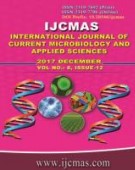


 National Academy of Agricultural Sciences (NAAS)
National Academy of Agricultural Sciences (NAAS)

|
PRINT ISSN : 2319-7692
Online ISSN : 2319-7706 Issues : 12 per year Publisher : Excellent Publishers Email : editorijcmas@gmail.com / submit@ijcmas.com Editor-in-chief: Dr.M.Prakash Index Copernicus ICV 2018: 95.39 NAAS RATING 2020: 5.38 |
Allelopathy defined as the harmful effect of chemical released by one plant or microorganism on another plant or microorganism. Interaction among species through the release of chemicals and these chemicals are recognized as allelochemicals. These are released by various processes volatilization, root exudation, leaching and decomposition of plant residues. The allelopathic effect in fruit crop is observed in two ways allo-inhibition and auto-inhibition. In fruit crop many allelochemicals was identified like mangiferin in mango, hydrojuglone in black walnut, kavin, yagonin, dihydromethysticin and coumarin in passion fruit, epicatechin, procyanidin A2, kaempferol-3-0-galactose and 4-hydroxybenzaldehyde in litchi, zizynummin, dammarane and saponin in ber. Allelopathic compounds released from different fruit crops have both stimulatory as well as inhibitory effect in agriculture ecosystem, such as in weed control (compounds from mango, passion fruit, litchi leaves), inhibition of seed germination and seedling growth (compounds from Black walnut, jamun, aonla and ber) and increase in soil microbial population around the rhizosphere (coconut), when they are planted closely. Allelochemicals are also used to treat venous insufficienciency and haemorrhoidal symptomatology. Allelochemicals, juglone having a maximum potential as a specific bactericidal effects on E. amylovora, which is causal organism of fire blight in apple. Allelopathic influence of fruit crop shows both inhibitory and stimulatory effect on other living organism, which needs further studies for their beneficial effect in agriculture ecosystem.
 |
 |
 |
 |
 |